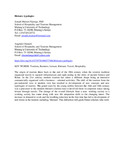| dc.contributor.author | Njoroge, Joseph M. | |
| dc.contributor.author | Chemeli, Angelah | |
| dc.date.accessioned | 2022-02-23T13:08:33Z | |
| dc.date.available | 2022-02-23T13:08:33Z | |
| dc.date.issued | 2022-07 | |
| dc.identifier.citation | Chapter in: Encyclopedia of Tourism Management and Marketing Edited by Dimitrios Buhalis. | en_US |
| dc.identifier.uri | https://doi.org/10.4337/9781800377486.bleisure.typologies | |
| dc.identifier.uri | https://www.elgaronline.com/view/nlm-book/9781800377479/b-9781800377486.bleisure.typologies.xml | |
| dc.identifier.uri | http://hdl.handle.net/123456789/5519 | |
| dc.description.abstract | The origin of tourism dates back to the end of the 18th century when the western tradition organized travels to support infrastructure and sight-seeing in the cities of ancient Greece and Rome. In the 21st century modern tourism has taken a different shape being an intensive commercially organized with a business – oriented activities. The shift of the tourism from the pre-industrial view to modern view has resulted to development of new concepts and new typologies of tourists. The grand tours by the young nobles between the 16th and 18th century was a precursor to the modern bleisure tourism since it involved those in corporate status taking leisure through travels. The change of the overall lifestyle from a non- working society to a working society has come along with new life adaptation skills to the changing times. The increase in demand to work and the resulting reduction in the free time has led to development of new terms in the tourism including ‘bleisure’ This definition will guide future scholars who wish | en_US |
| dc.language.iso | en | en_US |
| dc.subject | Tourism, Business, Leisure, Bleisure, Travel, Hospitality | en_US |
| dc.title | Bleisure typologies | en_US |
| dc.type | Book chapter | en_US |

